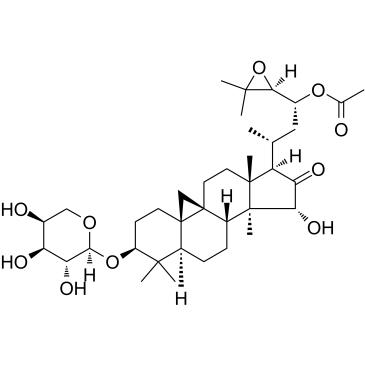
Acetylcimigenol 3-O-alpha-L-arabinopyran
CAS No. 402513-88-6
Acetylcimigenol 3-O-alpha-L-arabinopyran ( —— )
Catalog No. M18524 CAS No. 402513-88-6
Acetylshengmanol Arabinoside is isolated from Cimicifugae rhizoma.
Purity : 98%
 COA
COA
 Datasheet
Datasheet
 HNMR
HNMR
 HPLC
HPLC
 MSDS
MSDS
 Handing Instructions
Handing Instructions
| Size | Price / USD | Stock | Quantity |
| 5MG | 77 | In Stock |


|
| 10MG | 111 | In Stock |


|
| 25MG | 178 | In Stock |


|
| 50MG | 264 | In Stock |


|
| 100MG | Get Quote | In Stock |


|
| 200MG | Get Quote | In Stock |


|
| 500MG | Get Quote | In Stock |


|
| 1G | Get Quote | In Stock |


|
Biological Information
-
Product NameAcetylcimigenol 3-O-alpha-L-arabinopyran
-
NoteResearch use only, not for human use.
-
Brief DescriptionAcetylshengmanol Arabinoside is isolated from Cimicifugae rhizoma.
-
DescriptionAcetylshengmanol Arabinoside is isolated from Cimicifugae rhizoma.
-
Synonyms——
-
PathwayOthers
-
TargetOther Targets
-
RecptorOthers
-
Research Area——
-
Indication——
Chemical Information
-
CAS Number402513-88-6
-
Formula Weight662.86
-
Molecular FormulaC37H58O10
-
Purity98%
-
Solubility——
-
SMILESCC7(C)O[C@H]7[C@H](OC(C)=O)C[C@@H](C)[C@H]6C(=O)[C@H](O)[C@]2(C)[C@]6(C)CC[C@]35C[C@@]54CC[C@H](O[C@@H]1OC[C@H](O)[C@H](O)[C@H]1O)[C@@](C)(C)[C@@H]4CC[C@@H]23
-
Chemical Name——
Shipping & Storage Information
-
Storage(-20℃)
-
ShippingWith Ice Pack
-
Stability≥ 2 years
Reference
molnova catalog


related products
-
DL-Menthol b
DL-Menthol has short term toxicity in rats, it plays a role in the induction of surgical anesthesia in fishes, related at least in part to the activation of GABAA receptors.
-
Sodium taurodeoxycho...
Sodium taurodeoxycholate hydrate has been used in a study to assess the effect of submicellar concentrations of bile salts on the lipid bilayer membrane.
-
Soyasaponin Bb
Soyasaponin Bb can suppress Eca-976 cell growth, reverse effects on over expression of c-met, VEGF, and induce cell apoptosis through inhibiting HDAC1-NF-kappaB and activating PETEN and caspase-3 signaling pathways.



 Cart
Cart
 sales@molnova.com
sales@molnova.com


